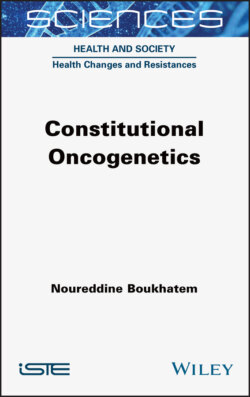Читать книгу Constitutional Oncogenetics - Noureddine Boukhatem - Страница 41
1.10.5. Reproductive options
ОглавлениеFor patients of childbearing age, it is recommended to advise them on options for prenatal diagnosis and assisted human reproduction, including preimplantation genetic diagnosis. The discussion should include the known risks, limitations and benefits of these technologies.
Biallelic mutations in some genes, such as BRCA2 and some other genes included in gene panels, may be associated with rare autosomal recessive conditions. Thus, for these types of genes, partner testing for mutations in the same gene would be considered if it were to be used as a basis for reproductive decision making and/or risk assessment and management.
Figure 1.5. Fanconi disease: autosomal recessive transmission. Both parents are carriers of BRCA2 mutations. Medical history of the baby includes abnormalities of fetal development, small size, bone marrow dysplasia, Wilms’ tumor at 7 months, neuroblastoma at 11 months and medulloblastoma tumor at 19 months
DEFINITION.– Medulloblastoma is a rapidly growing type of cancer that forms in the cerebellum. Medulloblastoma tends to spread through cerebrospinal fluid to the spinal cord or other parts of the brain. It can also spread to other parts of the body, but this is rare. Medulloblastoma is more common in children and young adults. It is a type of embryonic tumor of the central nervous system.
DEFINITION.– Neuroblastoma is a type of cancer that develops from immature nerve cells. It usually begins in the adrenal glands, but can also start in the abdomen, chest or nerve-vessel tissues near the spine. Neuroblastoma occurs most often in children under 5 years of age. It is thought to begin before birth.
DEFINITION.– Wilms’ tumor is a rare kidney cancer that mainly affects children. Also known as nephroblastoma, it is the most common kidney cancer in children. Wilms’ tumor most often affects children between the ages of 3 and 4 years and becomes much less common after the age of 5 years.
Currently, it is generally recommended that women with PALB2 mutations follow the breast cancer risk management guidelines described above for women with BRCA1/2 mutations.
Carriers of CHEK2 and NBN mutations are also eligible for breast MRI screening since their cumulative lifetime risk is greater than 20%. The magnitude of the lifetime risk associated with some low penetrance genes is unclear, such as RAD51C and BARD1, and as such, MRI is not recommended in these cases.
The NCCN guidelines currently suggest active breast MRI monitoring for patients with CHEK constitutional mutations.
For patients with deleterious RAD51C mutations, NCCN recommends prophylactic bilateral adnexectomy to reduce risk but states that routine monitoring or intervention for breast cancer is not indicated due to insufficient evidence.
It has been accepted that BRIP1 confers a sufficient risk of ovarian cancer, so prophylactic bilateral adnexectomy should be considered.
1 1 The criteria for risk assessment and genetic testing are not identical. For the purposes of these guidelines, invasive breast cancer and ductal carcinoma in situ should be included. The maternal and paternal sides of the family should be considered independently for familial forms of cancer.
2 2 This includes fallopian tubes and primary peritoneal cancers. BRCA-related ovarian cancers are associated with non-mucinous epithelial histology. Lynch syndrome may be associated with both non-mucinous and mucinous epithelial tumors. Clinical signs of Lynch syndrome should be monitored. Specific types of non-epithelial ovarian cancers and tumors may also be associated with other rare syndromes. Examples include an association between tumors of the sex cord with annular tubules and Peutz–Jeghers syndrome or Sertoli–Leydig tumors and DICER-related disorders.
3 3 Two primary breast cancers include bilateral (contralateral) neoplasia or two (or more) distinct homolateral primary tumors diagnosed either synchronously or asynchronously.
4 4 Close blood relatives include first-, second-, and third-degree relatives.
5 5 For populations at increased risk due to founding mutations, inclusion requirements may be modified.
6 6 For lobular breast cancer with a family history of diffuse gastric cancer, CDH1 gene testing should be considered.
7 7 For dermatological manifestations, see section 14.1.1 for Cowden syndrome.
8 8 For hamartomatous colon polyps in association with breast cancer and hyperpigmented macules of the lips and oral mucosa, an STK11 test should be considered (Peutz–Jeghers syndrome). Melanomas have been reported in some BRCA-related families.
9 9 Women should know their breasts and promptly report changes to their treating physicians. Periodic breast self-examination can help to recognize breast changes. In premenopausal women, the most informative self-examinations are those performed at the end of menstruation.
10 10 Randomized trials comparing the performance of clinical breast examination to its absence have not been conducted. The rationale for recommending a clinical breast examination every 6–12 months stems from the concern that breast cancer may develop in the time between examinations.
11 11 The suitability of imaging modalities and their programming are still under investigation.
12 12 Breast MRI is preferred because of the theoretical risk of radiation exposure in mutation carriers.
13 13 Limitations of high-quality breast MRI include the need for a dedicated breast coil, the ability to perform an MRI-guided biopsy, experienced breast MRI radiologists and regional availability. Breast MRI is preferably performed on days 7–15 of the menstrual cycle in premenopausal women.
14 14 In view of the high rate of occult neoplasia, particular attention should be paid to the sampling and pathological examination of the ovaries and fallopian tubes.
15 15 There are limited data to support breast imaging in men.
16 16 Whole skin and eye examinations are required for melanomas and investigation protocols for pancreatic cancer.
